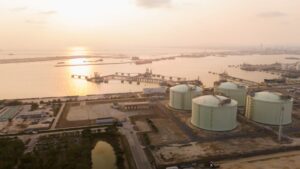One should understand the importance of proper storage and containment of the materials and chemicals used in your operations. Above ground storage tanks are a common method for safely and securely holding liquids and gasses on site. However, these storage solutions can be vulnerable to damage and leaks from extreme weather events thus understanding weather effects on aboveground Storage Tanks is important.
Before selecting and installing above ground storage tanks at your facility. You need to consider your location’s climate and weather patterns. Some weather conditions like high winds, flooding, lightning strikes, and temperature extremes. Improper design and above ground storage tank maintenance can potentially impact their integrity and functioning.
By planning ahead and choosing storage tanks suited to your environmental conditions, you can help prevent weather-related issues that lead to costly damages, disruptions, compliance violations and risk to health and safety.
With the right preparation and precautions taken, above ground storage tanks can continue serving as a reliable and secure storage method at your industrial plant through all seasons and weather events. However, you must keep in mind weather and climate to safeguard your operations, employees, community, and the environment. As a responsible business owner, you understand that weather and above ground storage tanks are factors that go hand in hand.
Weather Conditions Effecting Aboveground Storage Tanks
Here are some weather Conditions effecting Aboveground Storage Tanks.
How Extreme Heat Affects Above Ground Storage Tanks?
Extreme heat can pose several risks to above ground storage tanks. Prolonged exposure to high temperatures:
Accelerates corrosion.
Elevated temperatures speed up chemical reactions that cause corrosion in metals like steel. This can reduce the thickness and integrity of tank walls and seams over time. To minimize storage tank corrosion, choose a high-quality steel alloy and protective coating designed for high-heat applications.
Increases pressure buildup.
As the temperature of the liquid in the tank rises, so does its pressure. This can exceed the maximum pressure rating of the tank if not properly vented. Ensure your tank has adequate vents and pressure relief valves to safely release excess pressure.
Reduces structural stability
High heat causes metals like steel to expand, which can warp and weaken the tank structure. This also places added stress on welds and seams. For high-temperature locations, choose a tank with reinforced insulation and structural supports.
Intensifies fire risk.
Extremely high temperatures increase the chances of adjacent materials spontaneously combusting and igniting a fire. This poses a major hazard, especially if the tank contains flammable liquids. Proper fireproofing, ventilation, and fire suppression equipment are critical.
To protect your above ground storage tanks in extreme heat, prioritize high-quality temperature-resistant materials, safety mechanisms like pressure vents, adequate structural reinforcement, fireproofing, and routine inspections. With proactive safeguards and maintenance in hot weather, you can help ensure the longevity and safe operation of your tanks.
The Impact of Cold Weather on Above Ground Tanks
Cold weather can significantly impact above ground storage tanks. As temperatures drop, the materials and components of a tank contract and harden, which can lead to damage if proper precautions are not taken.
Heating requirements
Above ground tanks require heating equipment to maintain the temperature of stored liquids. Insufficient heating can cause liquids to gel or solidify, damaging pumps and pipes. Thermostatically controlled heaters help ensure temperatures stay within an optimal range based on the specific materials being stored.
Snow and ice accumulation
Accumulated snow and ice put extra weight and pressure on tank roofs, seals, and components. Excessive buildup should be removed to prevent damage to the tank. Some tanks are engineered to hold a maximum snow load rating that should not be exceeded. One should consider freezing point of petrol which is between -40 and -50 degrees Celsius.
Emergency vents
Vent caps and other tank openings must remain clear to properly ventilate the tank and release excess pressure. Built-up snow and ice can block vents, creating a hazardous situation. Emergency pressure relief valves may need to be insulated and heat traced to prevent freezing in extremely cold temperatures.
Condensation control
Temperature changes can lead to condensation buildup inside the tank, which promotes corrosion. Proper insulation, heat tracing of piping, and ventilation help control condensation. An interior lining or coating may also be required for some tank materials.
By adequately preparing above ground storage tanks for cold weather conditions, damage and hazardous situations can be avoided. Staying on top of heating, snow removal, vent clearing, and condensation control will help ensure a safe and efficient operation.
High Winds and Above Ground Storage Tanks: Prepare for the Worst
High winds can pose serious risks to above ground storage tanks. Prepare your tanks to withstand even the strongest gusts by following these recommendations:
Inspect and Reinforce Tank Foundations
The foundation supports the entire weight of the tank, so inspect it regularly for any signs of damage or deterioration. Reinforce or repair the foundation as needed to ensure it remains level and secure. If the foundation shifts or becomes unstable due to high winds, it could cause the tank to topple over, releasing its contents.
Anchor Tanks Securely
Anchor tanks to concrete foundations using sturdy metal straps or bolts to prevent them from toppling over during high winds. The anchors should be installed at multiple points around the base of the tank. For the best protection, choose anchors rated to withstand wind speeds in excess of 100 mph.
Maintain Tank Accessories
Components like ladders, railings, gages, and pipes attached to the tank can become loose or detach completely under high wind conditions. Inspect all tank accessories regularly and repair or replace any damaged parts to prevent them from becoming airborne projectiles during a storm.
Consider Installing Wind Barriers
For added protection, install reinforced wind barriers such as concrete or steel walls around some or all sides of the tank. The barriers should be high enough to shield the tank from the strongest anticipated wind gusts in your area. Wind barriers can help deflect the force of the wind, preventing damage to the tank and its foundation.
By taking proactive steps to prepare your above ground storage tanks for high wind events, you can help minimize the risks of catastrophic failure, environmental contamination, and financial loss. Regular maintenance and structural reinforcements are the keys to keeping your tanks stable and secure, even during the most powerful storms. With the proper safeguards in place, your tanks will stand up to the test when facing severe weather.
Heavy Rains, Flooding and Your Above Ground Tank Installation
Heavy rains and flooding can pose risks to above ground storage tanks. It is important to take proper precautions to avoid damage or leaks from these weather events.
When there are heavy rains, especially for an extended period of time, the ground around the tank foundation and anchorage can become saturated and unstable. This can cause the tank to tilt or even collapse. To prevent this, choose a site with well-draining soil and a high water table for installing the tank. You may also need to reinforce the foundation with concrete pillars that extend down to solid ground.
Secure the tank to concrete anchors that are embedded in deep foundations to prevent it from floating due to buoyancy during flooding. Test the anchorage to ensure it can withstand the uplift forces from a flood. You may need to increase the number or size of anchors for tanks in flood-prone areas.
Another concern is that as rain and flood waters rise, they can enter the tank through vents, pipes, or seals and contaminate the contents. Equip your tank with an emergency shutoff valve that can quickly close all openings to the inside. The vents and pipes should also have raised openings well above expected flood levels.
Inspect your above ground storage tanks regularly, especially after heavy rains or floods. Check for any signs of damage, leaks, or spills and perform necessary repairs or maintenance right away. It is also a good idea to create an emergency plan in case of a leak or spill from the tank during adverse weather. By taking the proper safeguards and precautions, your above ground tanks can withstand challenging weather conditions with minimal issues.
Frequent monitoring and maintenance, combined with emergency planning and preparedness, are key to protecting your above ground storage tanks from damage due to heavy rains, flooding and other severe weather events. Putting in place reinforced foundations, anchors, shutoff valves and raised vents will give you greater peace of mind that your tank installation can handle whatever weather comes its way.
Lightning Strikes: Protect Your Above Ground Storage Tanks
Lightning strikes can pose a serious threat to above ground storage tanks if proper precautions aren’t taken. As a tank owner, it’s crucial to understand the dangers of lightning and how to safeguard your tanks.
Installing Lightning Protection Systems
The most effective way to protect above ground storage tanks from lightning damage is to install a lightning protection system. These systems provide a path to ground for electrical charges, preventing them from accumulating in the tank. Common components include air terminals, down conductors, and grounding rods. We install air terminals at the highest points of the tank to capture electrical charges. Down conductors carry the charges from the air terminals to grounding rods, which disperse the energy into the earth.
Choosing the Right Grounding Method
There are two main types of grounding for lightning protection systems: resistance grounding and isolated grounding. Resistance grounding uses grounding rods to provide a path to ground with some resistance, which helps limit fault currents. Isolated grounding completely separates the tank from other equipment and structures. For above ground storage tanks, isolated grounding is generally the safer choice as it prevents unwanted electrical interactions.
Inspecting and Maintaining the System
Once installed, the lightning protection system requires ongoing storage tank inspection and maintenance to ensure proper functioning. Inspect air terminals and down conductors visually for signs of damage or corrosion at least once a year and after any severe storms. Verify that grounding rods and connections still provide a secure, low-resistance path to ground. Immediately address any issues discovered during inspections to maintain maximum protection.
Tank owners can rest assured their tanks are well-protected from the threat of lightning strikes and the damage they can cause by putting the proper safeguards in place for above ground storage. Installing specialized lightning protection systems, choosing effective grounding methods, and performing routine inspections are the best ways tank owners can mitigate the risks posed by lightning.
Conclusion
As the owner of above ground storage tanks, being aware of the potential impact of weather is critical to ensuring the safe operation of your tanks and avoiding expensive damage or hazardous situations. One should consider Aboveground storage tank Checklist and maintenance Careful monitoring, and emergency preparedness can help mitigate risks from extreme heat, flooding, high winds, and temperature changes. By understanding the specific threats that are relevant for your tanks and location, and having systems in place to address them, you can feel confident that your storage tanks are properly equipped to withstand what nature may bring, even though the variety of weather events that can influence above ground tanks may seem daunting. Protecting your business assets and the environment requires vigilance, but with the right safeguards and oversight in place, above ground storage tanks can continue serving their important purpose for years to come.




